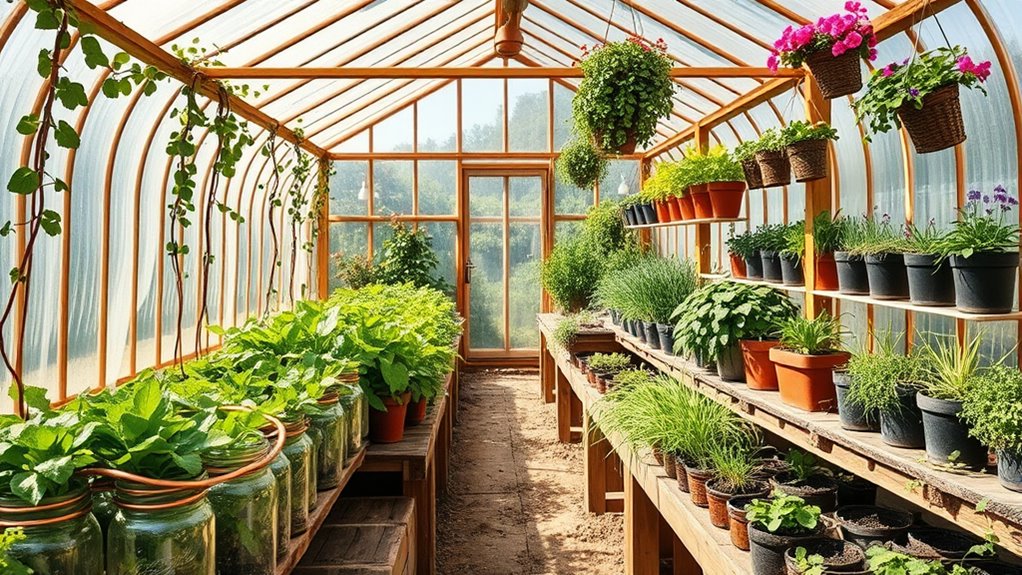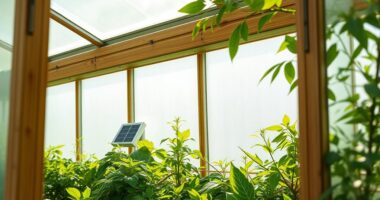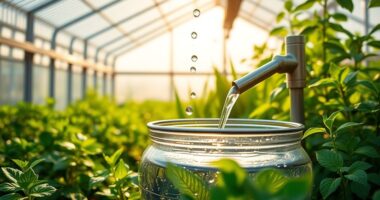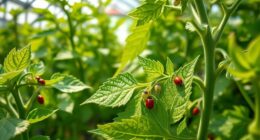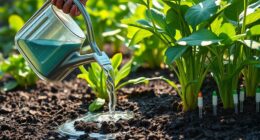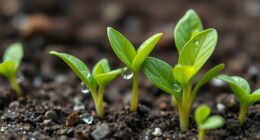Recycling and reusing in your greenhouse helps cut waste and saves money while supporting sustainability. You can turn old buckets, jars, and shoe organizers into planters and use repurposed trays for seedlings. Composting organic scraps like kitchen waste and garden clippings improves soil naturally. Building structures from recycled wood or bottles reduces costs, and creating natural pest controls keeps plants healthy. Recycling water through gutters and rain barrels maintains efficiency—discover more ways to make your greenhouse eco-friendly and cost-effective.
Key Takeaways
- Repurpose containers like buckets and jars into planters with drainage for sustainable planting.
- Use recycled materials such as reclaimed wood and old windows to construct eco-friendly greenhouse structures.
- Incorporate compost bins for organic waste to produce natural fertilizer and reduce landfill waste.
- Implement water recycling systems using rain barrels and drainage channels to conserve water.
- Apply eco-friendly pest control methods, including beneficial insects and organic sprays, to minimize chemical use.
Repurposing Containers for Planting
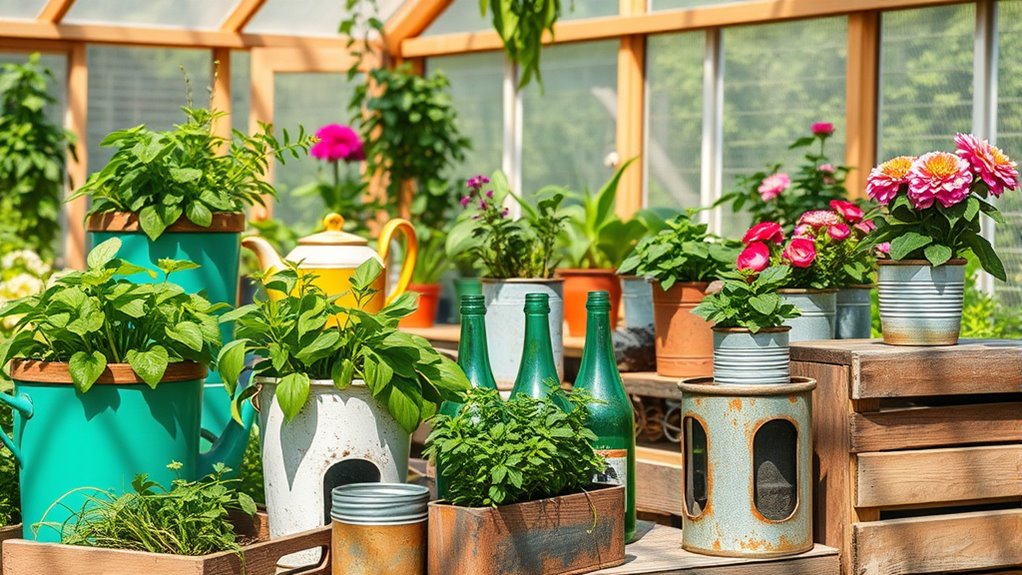
Repurposing containers for planting is an effective way to reduce waste and give new life to items you might otherwise discard. You can transform old buckets, jars, or even shoe organizers into practical planters. Using seed starting trays made from repurposed materials allows you to nurture seedlings efficiently, saving money and space. Incorporate drip irrigation systems into your repurposed containers to ensure consistent watering without waste. Drip systems can be easily adapted to various container sizes, making watering more efficient and less labor-intensive. Additionally, choosing appropriate paint or sealant ensures that repurposed containers are safe for plants and durable against weather conditions. Selecting weather-resistant materials can further extend the lifespan of your containers and protect your plants from environmental damage. Understanding plant compatibility with different container types can further enhance your gardening success. Proper drainage is also essential, so consider adding drainage holes or using gravel at the bottom of containers to prevent waterlogging, which aligns with the use of hydrocolloid technology to improve moisture control in plant containers. Incorporating sustainable practices can also help you maintain an eco-friendly greenhouse environment.
Composting Organic Waste Effectively
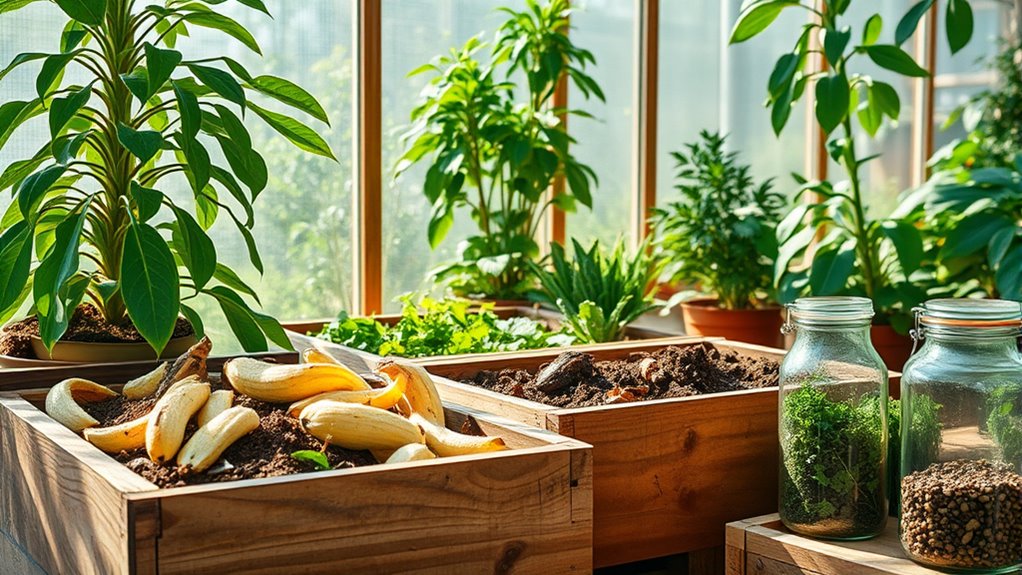
To keep your greenhouse eco-friendly and reduce waste, composting organic materials effectively is vital. Start with a well-designed compost bin that promotes airflow and easy access. Proper organic waste sorting is essential—separate kitchen scraps, garden clippings, and paper to maintain a balanced compost. Use a bin with good drainage and aeration to speed up decomposition. Regularly turn the compost to ensure even breakdown. Keep an eye on moisture levels; it should be damp but not soggy. Additionally, choosing the right composting materials can significantly influence the quality and efficiency of your compost pile. Incorporating carbon-to-nitrogen ratios helps optimize microbial activity and decomposition speed. Here’s a quick guide:
| Material Type | Suitable for Composting |
|---|---|
| Fruit & Vegetable Waste | Yes |
| Garden Clippings | Yes |
| Paper & Cardboard | Yes, shredded |
| Meat & Dairy | No, attracts pests |
| Plastic & Metals | No, non-biodegradable |
Effective composting reduces waste and enriches your soil naturally. Proper composting practices can also help mitigate air quality concerns by reducing organic waste sent to landfills and promoting sustainable gardening practices. Incorporating composting into your routine can also help you better understand waste management and improve overall environmental impact.
Using Recycled Materials for Greenhouse Structures
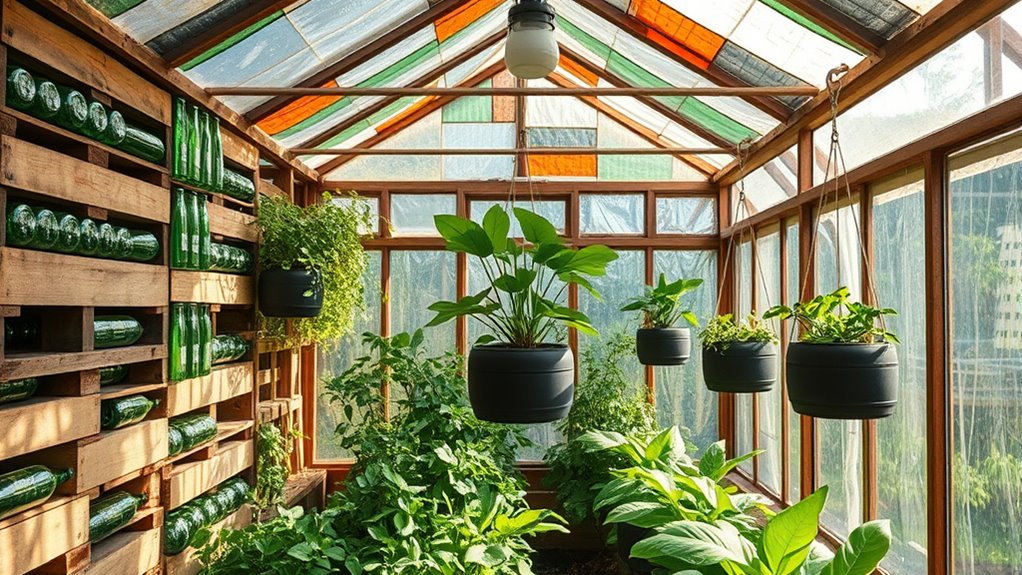
Using recycled materials to build your greenhouse structures is an eco-friendly way to reduce waste and lower costs. By repurposing items like reclaimed wood, old windows, or leftover metal, you support sustainable building practices that minimize environmental impact. These recycled materials not only contribute to eco friendly design but also add unique character to your greenhouse. You can use plastic bottles or pallets for framing, creating a cost-effective yet sturdy structure. Incorporating recycled materials encourages resourcefulness and reduces reliance on new resources. Additionally, recycled construction materials often have a distinct aesthetic that can enhance the overall appearance of your greenhouse. Implementing vertical storage solutions can help maximize space inside your greenhouse, making it more efficient and organized. Using different types of home security systems can also help protect your greenhouse from theft or vandalism. Plus, these choices promote a circular economy and help you maintain a smaller carbon footprint. Utilizing reclaimed building components further extends the life cycle of materials and supports eco-conscious gardening practices. Incorporating sustainable design principles can also improve energy efficiency and environmental benefits of your greenhouse.
Creating Eco-Friendly Pest Control Solutions
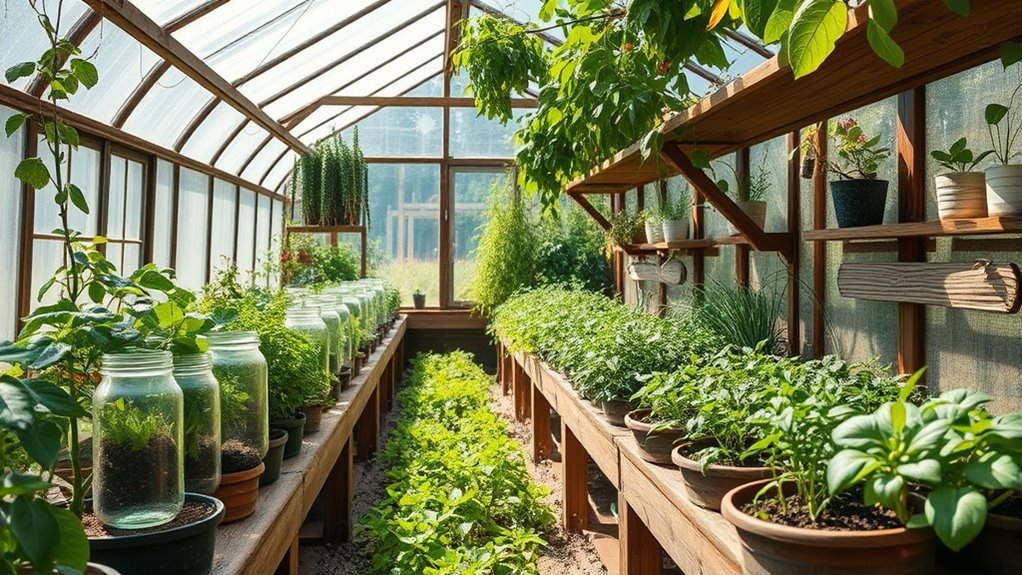
Creating eco-friendly pest control solutions is essential for maintaining a healthy greenhouse environment without relying on harmful chemicals. One effective approach is introducing natural predators, such as ladybugs or predatory mites, to target specific pests naturally. These beneficial insects help keep pest populations in check without posing risks to plants, humans, or beneficial insects. Incorporating biological control methods, such as using predatory insects, has been proven effective in sustainable greenhouse pest management. Eco-friendly practices also include selecting sustainable tourism methods like eco-conscious pest management strategies that minimize environmental impact. Additionally, organic sprays made from neem oil, insecticidal soaps, or garlic extract can provide targeted pest management without chemical residues. Regular monitoring allows you to identify infestations early and apply these natural solutions promptly. Employing mindfulness techniques during pest inspection can improve your focus and ensure thorough detection of pests before they become unmanageable. Utilizing integrated pest management strategies can further optimize pest control by combining biological, cultural, and mechanical methods for maximum efficiency. Moreover, understanding the benefits of eco-friendly pest control can lead to healthier plants and a more sustainable growing environment.
Recycling Water and Managing Drainage
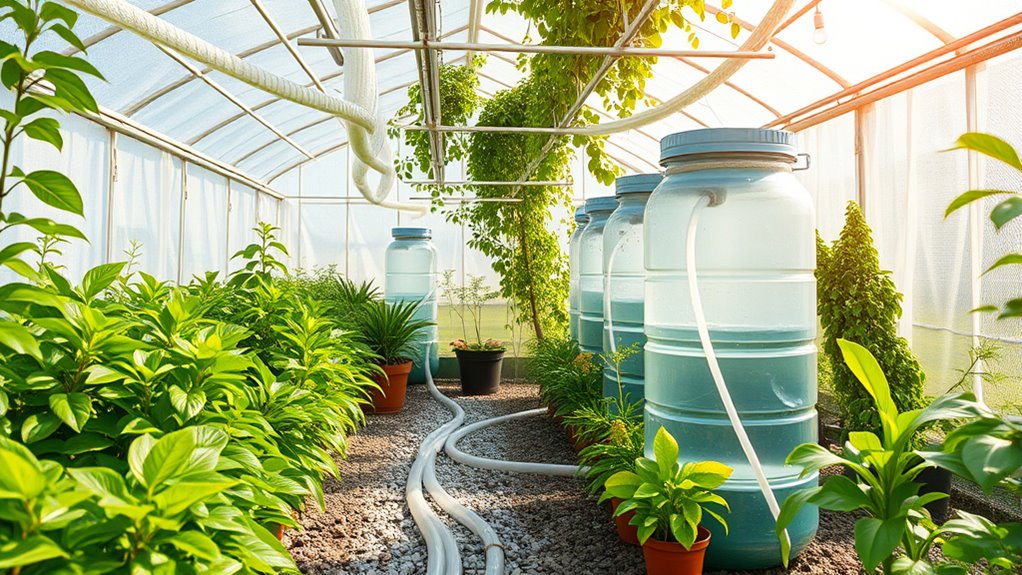
Have you considered how recycling water and managing drainage can boost your greenhouse’s sustainability? Implementing efficient drainage systems helps prevent waterlogging and soil erosion, guaranteeing your plants stay healthy.
Collecting runoff through gutters and drainage channels allows you to recycle water, reducing your overall consumption. You can set up rain barrels or underground tanks to store excess water for later use, promoting water conservation.
Regularly inspecting drainage systems ensures they work effectively and prevents clogs that could lead to overflows or pests.
Frequently Asked Questions
How Can I Identify Non-Toxic Recycled Materials Safe for Plants?
To identify plant-safe materials, look for non-toxic indicators like labels or certifications from trusted sources such as the EPA or FSC.
Avoid recycled materials with chemical residues or unclear origins.
Test unfamiliar items by placing them in water and observing for harmful leaching, or consult experts.
Always prioritize plant-safe materials to prevent toxicity, ensuring your greenhouse remains a healthy environment for your plants.
What Are the Best Practices for Sorting Recyclable Waste in a Greenhouse?
Imagine a neat, colorful bin system guiding your waste flow like a well-tended garden path. To sort recyclable waste effectively, you should implement clear labels, separate composting techniques, and dedicated containers for plastics, metals, and organics.
This keeps your greenhouse tidy and promotes waste reduction strategies. By actively managing your waste, you create a sustainable environment, ensuring each material is properly processed and reused, nurturing your plants and your eco-friendly goals.
How Do I Ensure Recycled Materials Meet Building Safety Standards?
To make certain recycled materials meet building safety standards, you need to oversee the recycling process carefully. Check that the materials have proper certification, confirming they meet safety regulations.
Always source from reputable suppliers who provide documentation verifying material quality. Conduct your own inspections if necessary, and stay updated on current building codes.
This way, you guarantee that the recycled materials used in your greenhouse are safe, durable, and compliant with standards.
Can Recycled Plastics Release Harmful Chemicals Into Plants or Soil?
You might wonder if recycled plastics cause plastic leaching or chemical contamination in your plants or soil. While some plastics can release harmful chemicals over time, choosing food-grade or BPA-free recycled plastics minimizes this risk.
Regularly inspect your containers for wear, and avoid plastics that show cracks or discoloration. Properly selecting and maintaining recycled plastics helps prevent chemical contamination and keeps your greenhouse environment safe for plants.
What Local Regulations Govern Recycling and Reuse in Greenhouses?
Think of local regulations as the guiding stars in your greenhouse journey. You must navigate municipal waste policies and environmental compliance to keep your operation lawful and eco-friendly. These rules act like a shield, protecting your plants and soil from harm.
Conclusion
By recycling and reusing in your greenhouse, you turn waste into vibrant life, like turning old jars into blooming planters or discarded wood into sturdy shelves. Imagine the contrast: trash transformed into thriving greenery, a demonstration of your eco-conscious efforts. Every reused container and recycled material breathes new purpose into your space, creating a lush sanctuary amid the clutter. Embrace these sustainable practices, and watch your greenhouse flourish, a beautiful harmony of waste turned wonder.
